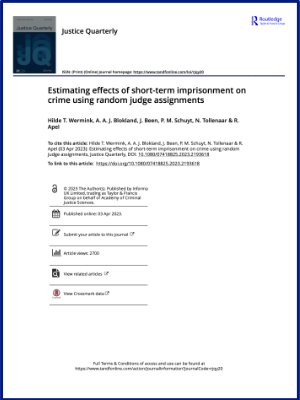By Hilde T. Werminka, A. A. J. Bloklanda,b, J. Beenc, P. M. Schuyt, . N. Tollenaare and R. Apel;
Noncustodial sanctions may present an attractive way to reduce the prison population rate, but only when noncustodial sanc-tions meet custodial ones in terms of deterring recidivism. Using administrative criminal records data of all individuals convicted in the Netherlands in 2012, this study examines the effects of short-term imprisonment versus noncustodial sanctions on crime. We employ an instrumental variables approach to account for selection processes and to produce consistent estimates of the effects of imprisonment. Findings indicate that being sentenced to prison rather than a noncustodial sanction increases the prevalence of recidivism by 10 percentage points and increases recidivism rates by 1.07 registered crimes during a follow-up period of three years. Treatment effect heterogeneity analyses show that the detri-mental impact of imprisonment is most pronounced for first-time prisoners, and adult offenders, compared to repeat prisoners and young adult offenders.IntroductionReducing the prison population is one of the biggest challenges faced in the criminal justice system across countries worldwide. There are many good reasons to exercise restraint when it comes to imprisonment. For one, imprisoning people is an expensive enterprise, and the costs of imprisonment typically weigh heavy on the criminal justice budget (e.g. Phelps & Pager, 2016). To the extent that imprisonment maintains or even increases marginalization of the imprisoned population following their release, these direct costs may be dwarfed by imprisonment’s indirect societal costs
Justice Quarterly, April 2023.


